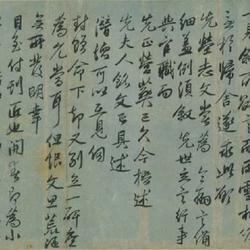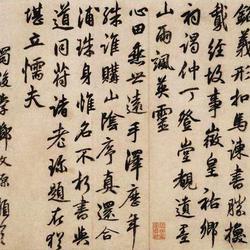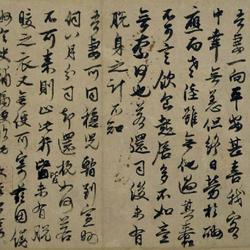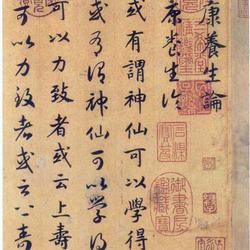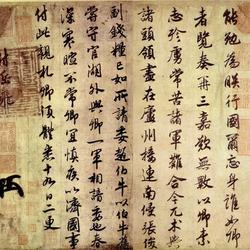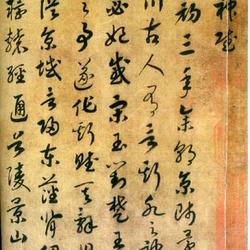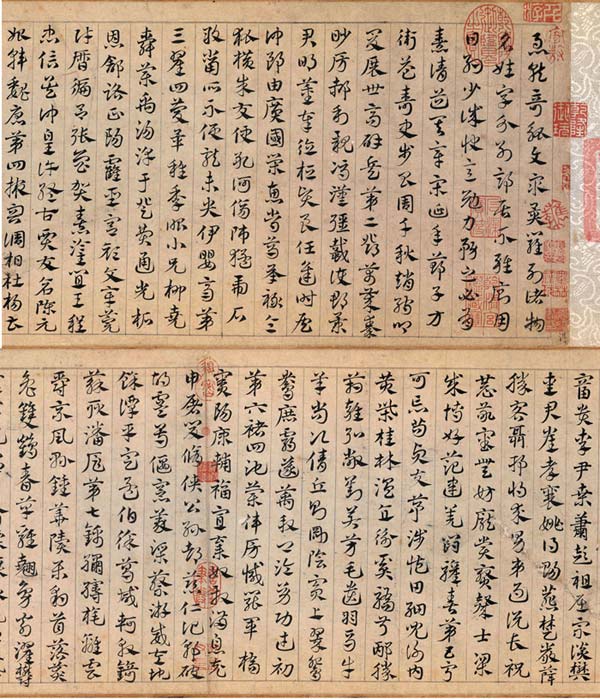
The urgent chapter (part of it) was written in the third year of Dade (1299). The paper is 23.3 cm long and 398.7 cm wide.
Collection of the Palace Museum, Beijing.
Zhangcao is an early form of cursive script. Each character is written independently and not consecutively. It retains the writing method of Bo Zhen in official script and is considered to be cursive writing in official script. Huang Bosi of the Song Dynasty said: "Any cursive script that is divided into waves is called 'Zhangcao'". Duan Yucai of the Qing Dynasty said: "The characters that are not continuous are called 'Zhangcao', and the characters that are continuous after the Jin Dynasty are called 'Jincao'". In the history of calligraphy, Shi You, Huang Xiang's "Emergency Chapter" and Suo Jing's "Ode to the Master" are all famous Zhang Cao works. Zhangcao has an ancient and profound atmosphere due to its structural characteristics and official calligraphy with ripples. Zhangcao developed into the Sui and Tang Dynasties, and gradually withdrew from the calligraphy world, almost becoming extinct.
However, in the Yuan Dynasty, there was a resurgence in Zhangcao, and several calligraphers who were good at writing Zhangcao appeared. The reason has something to do with Zhao Mengfu's advocacy of restoration. "He believed that the Yuan people resolutely abandoned the Tang and Song Dynasties and pursued the two Jin Dynasties. Although not without bias, he created a trend for Yuan and Ming calligraphy" (Chen Zhenlian's "Appreciation of Calligraphy of the Past Dynasties"), Zhao Mengfu is good at all kinds of styles, and Zhangcao is one of them. Deng Wenyuan of the Yuan Dynasty was as famous as Zhao Mengfu and Xian Yushu, and was known as the three great masters of the Yuan Dynasty. Deng Wenyuan was especially famous for his good calligraphy. Tao Zongyi of the Ming Dynasty said in "Shu Shi Hui Yao": "Deng Wenyuan, Zheng, Xing and Cao, followed the two kings early, and Li Beihai later." Deng Wenyuan's birth and death years were almost the same as those of Zhao Mengfu, and the two kings of Deng Xue were even earlier than Zhao Mengfu, but he still Like many calligraphers at that time, he was greatly influenced by Zhao Mengfu, and there are writings to prove it. For example, his regular script "Ti Ji" and running script "Zhi Jing Liang Lang Zhong" all look like Zhao Shu. From the above point of view, although Deng Wenyuan's calligraphy skills are deep and his methods are high, he lacks his own face and cannot be compared with Zhao Mengfu and Xian Yushu.
The paper version of Deng Wenyuan’s chapter cursive "Ji Ji Zhu Zhang" is written by Deng Lin Wu Huangxiang's chapter "Ji Ji Zhang". Huang Xiang's "Ji Ji Zhang" is well-knotted and has a strong legal code. Song Yangxin of the Southern Dynasties said: "The emperor of Wu was able to write grass and was known as calm in the world. "Happy". Comparing Deng Wen's original book with Huang Xiang's book, we can see that Deng basically inherited the advantages of Huang Xiang's book, but lacked some of the simplicity of Huang Xiang's book. Deng Shu's brushwork is also different from that of Huang Xiang. There is a huge difference between Deng Shu's fine brushwork and thick brushwork. Some strokes are as thin as gossamer, while the strokes are heavy and ruthless, with sharp and pointed edges, which are very conspicuous. Although this book is Linhuang Xiangshu, it is relatively close to the Zhangcao in the "Six-Titan Thousand-Character Essay" passed down as Zhao Mengfu's book, which reflects the writing characteristics and style of the Yuan Dynasty people. Song Kezhangcao in the Ming Dynasty also basically followed this line. way. On the contrary, several great masters of Zhang Cao in modern and modern times, especially Shen Zengzhi and Wang Zangchang, whose Zhang Cao surpassed the Yuan and Ming dynasties and went straight into the Jin and Sui dynasties. However, this is beside the point.

